12 Best Website Builders for Restaurants in 2025 (Reviewed)
This article was assisted with AI. We may include links to partners.
In the competitive food industry, your restaurant's website is a critical tool for driving reservations, managing online orders, and attracting new customers. The right platform streamlines your business and enhances your brand, while the wrong one leads to lost revenue. This guide will help you find the best website builders for restaurants, tailored to the unique demands of your establishment.
We've analyzed 12 top platforms, from the innovative Solo AI Website Creator to industry-specific powerhouses like BentoBox and all-in-one solutions like Wix Restaurants. For each option, you'll find a breakdown of its core features, pricing, and specific use cases. We focus on the essentials: integrated ordering and reservation systems, mobile-responsive menu designs, and marketing tools that help you connect with diners. Each review includes screenshots and direct links to help you evaluate the platforms firsthand.
Our goal is to provide a clear, practical resource that cuts through marketing fluff. We'll give you actionable insights and an honest assessment of each tool's strengths and limitations. Beyond choosing the right platform, enhancing your online presence also involves strategies for discoverability. You can learn more about effective SEO for restaurants to ensure potential customers find you easily. Let's find the perfect digital foundation for your restaurant.
1. Solo AI Website Creator
Solo AI Website Creator is a premier choice for restaurants needing a professional online presence without the cost or complexity. Its AI-driven platform is engineered for speed, allowing you to generate a fully functional, mobile-responsive website in minutes. By answering a few simple questions about your restaurant, the AI creates industry-specific layouts, images, and text, giving you a tailored starting point that feels uniquely yours.
This platform stands out as one of the best website builders for restaurants due to its completely free model, which includes custom domain hosting without any hidden fees or ads. This removes a significant financial barrier for new or budget-conscious restaurants.
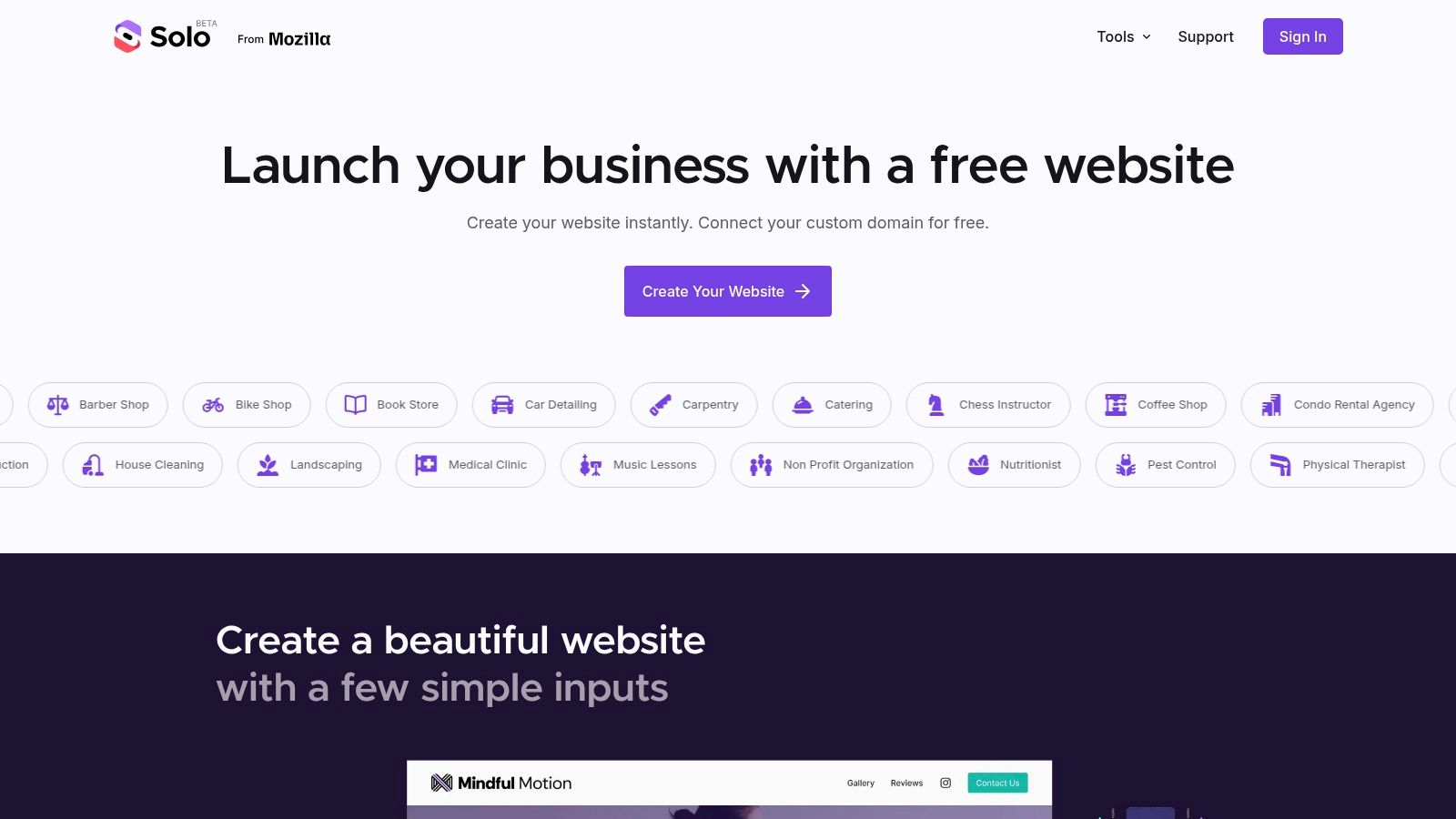
Key Features for Restaurants
Solo AI Website Creator's features are designed for the food service industry. The seamless integration with booking services like Calendly is perfect for managing reservations directly through your site. You can also embed contact forms for catering inquiries and import customer reviews to build trust.
For marketing, the Google Analytics integration provides data on visitor traffic, helping you understand your audience. While it lacks a native online ordering system, you can easily list menu items and link them to external payment or ordering platforms.
Actionable Tip: To handle online orders, create your menu page and add a "Pay Now" button next to each item using a service like PayPal or Stripe. This creates a simple ordering system without needing a full e-commerce setup.
Pros and Cons
-
Pros:
- Completely free: Includes custom domain hosting with no ads or hidden charges.
- AI-powered creation: Generates a professional, industry-specific website in minutes.
- Essential integrations: Connects with booking calendars, contact forms, and Google Analytics.
- User-friendly: No coding knowledge is required.
- Mobile-optimized: Ensures a flawless experience for customers on any device.
-
Cons:
- Limited e-commerce: No built-in shopping cart for direct online ordering or inventory management.
- Basic customization: Advanced design changes beyond the provided templates are limited.
Website: https://soloist.ai
2. Wix Restaurants
Wix Restaurants uses its globally recognized website creator and packages it with tools for the food service industry. It stands out by offering an all-in-one solution that integrates stunning, mobile-responsive templates with essential operational features right out of the box. This makes it one of the best website builders for restaurants that need to launch a professional site quickly without a steep learning curve.
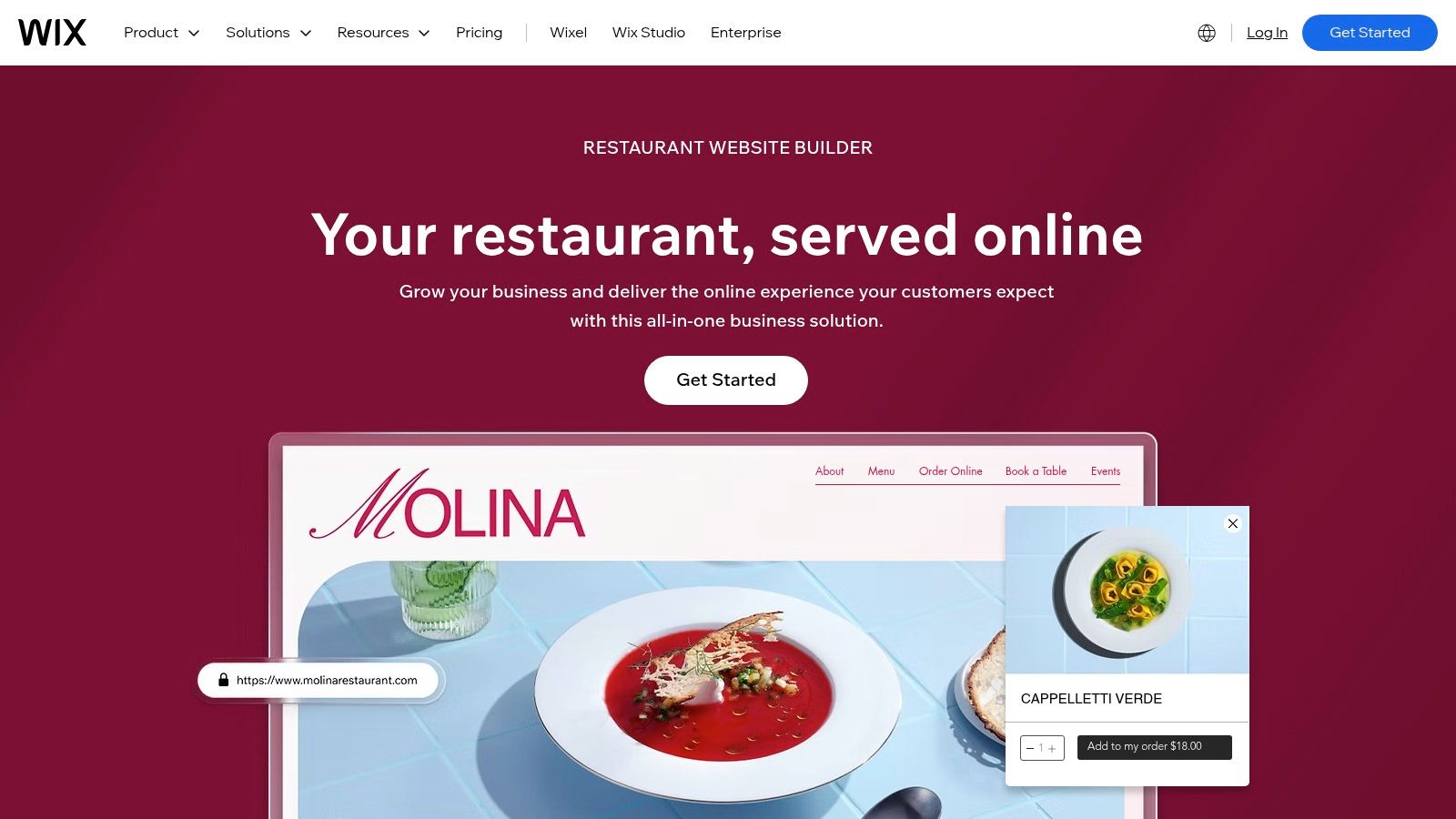
Unlike general-purpose tools, Wix provides dedicated restaurant templates with built-in online menus (Wix Menus), a commission-free online ordering system (Wix Ordering), and a native table reservation system (Wix Reservations). This unified approach simplifies management, as all orders and bookings are handled in one dashboard. You can also explore a comparison of Wix with other leading platforms in our full 2024 ranking of restaurant website builders.
Key Features and Considerations
Wix’s core strength is its drag-and-drop editor, which offers immense creative freedom. However, this can feel overwhelming for beginners.
- Pricing: Business plans are required to accept online payments, starting at around $27/month.
- Pros: Extremely fast setup, robust native ordering and reservation systems, and a massive app ecosystem.
- Cons: The number of design options can be complex, and relying on add-on apps can increase the total monthly cost.
- Best For: Restaurants wanting a polished, all-in-one digital presence with strong native features for ordering and reservations.
- Actionable Tip: Use the "Wix Restaurants Menus" app to create a visually appealing menu. Add high-quality photos for each dish and use labels like "Spicy" or "Vegan" to help customers make quick decisions.
3. Squarespace (Restaurant Websites)
Squarespace is the design-first choice, offering a sophisticated and visually driven platform. It excels at helping restaurants create a stunning online presence with minimal effort, focusing on aesthetics and brand identity. This makes it one of the best website builders for restaurants where the look and feel of the site are as important as the food, such as fine dining establishments or trendy cafes.
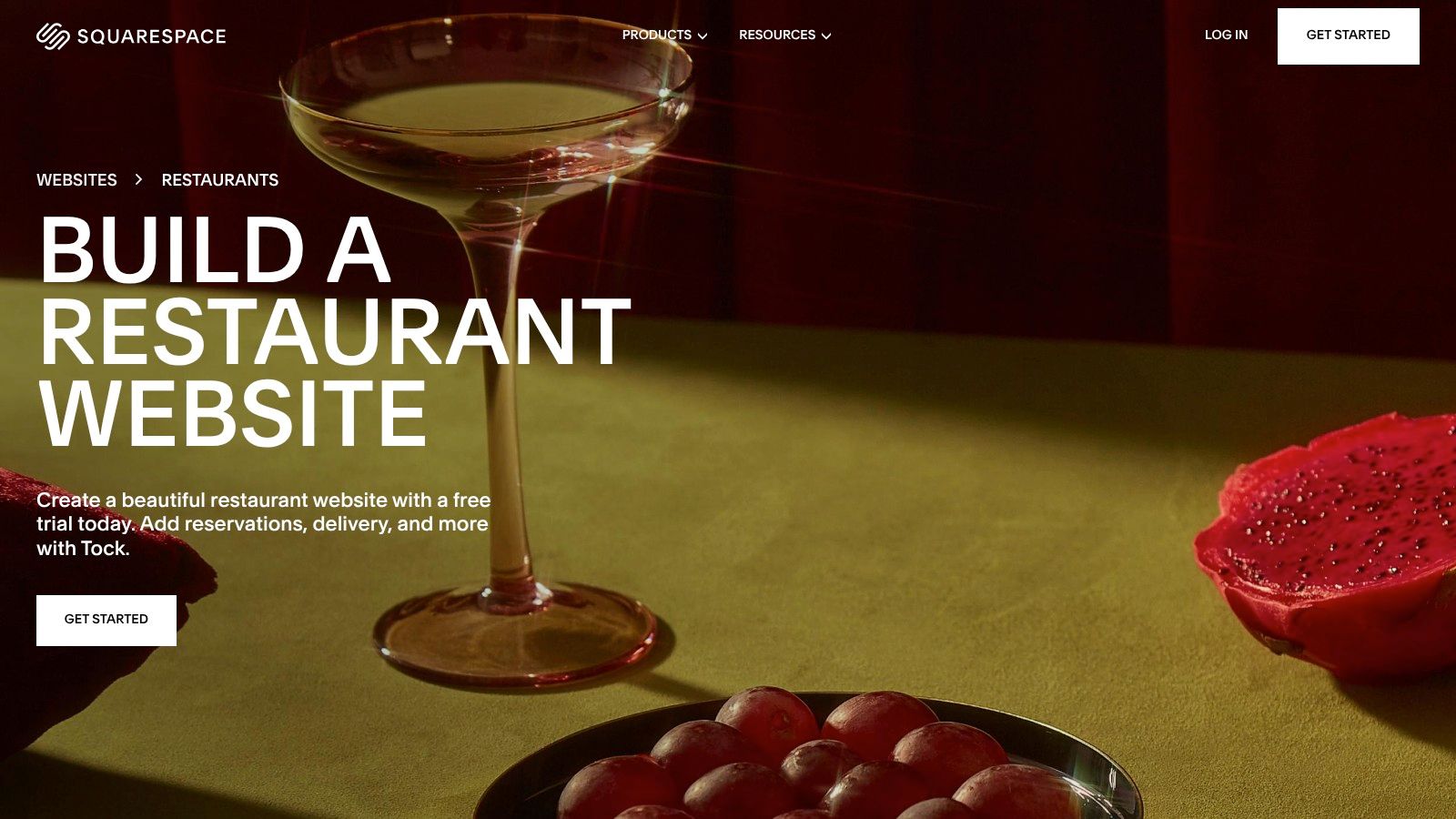
Instead of proprietary tools, Squarespace uses seamless integrations with industry leaders like Tock for reservations and ChowNow for commission-free ordering. This approach allows you to use best-in-class third-party services while managing your website through Squarespace’s intuitive interface. Dedicated menu blocks and professionally designed templates ensure that updating daily specials is straightforward.
Key Features and Considerations
Squarespace's core advantage is its award-winning design and ease of use, making it simple to maintain a high-end look.
- Pricing: Business plans, necessary for integrations, start at approximately $23/month when billed annually.
- Pros: Excellent design templates, a simple editor for quick menu updates, and growing native AI tools for marketing.
- Cons: Lacks a permanent free plan (only a trial is available), and its restaurant functionality relies on third-party integrations.
- Best For: Restaurants prioritizing brand image and design who prefer using established services like Tock and ChowNow.
- Actionable Tip: Use the "Menu Block" feature and upload your menu as text, not a PDF. This ensures your menu items are indexed by Google, improving your restaurant's visibility in search results.
4. Shopify for Restaurants
While known as a retail e-commerce giant, Shopify has adapted its platform for the food service industry, offering enterprise-grade reliability for online ordering. It excels for restaurants that view their online presence as a serious sales channel, providing robust tools for local pickup, delivery workflows, and tipping. This makes it one of the best website builders for restaurants planning to scale or manage multiple locations.
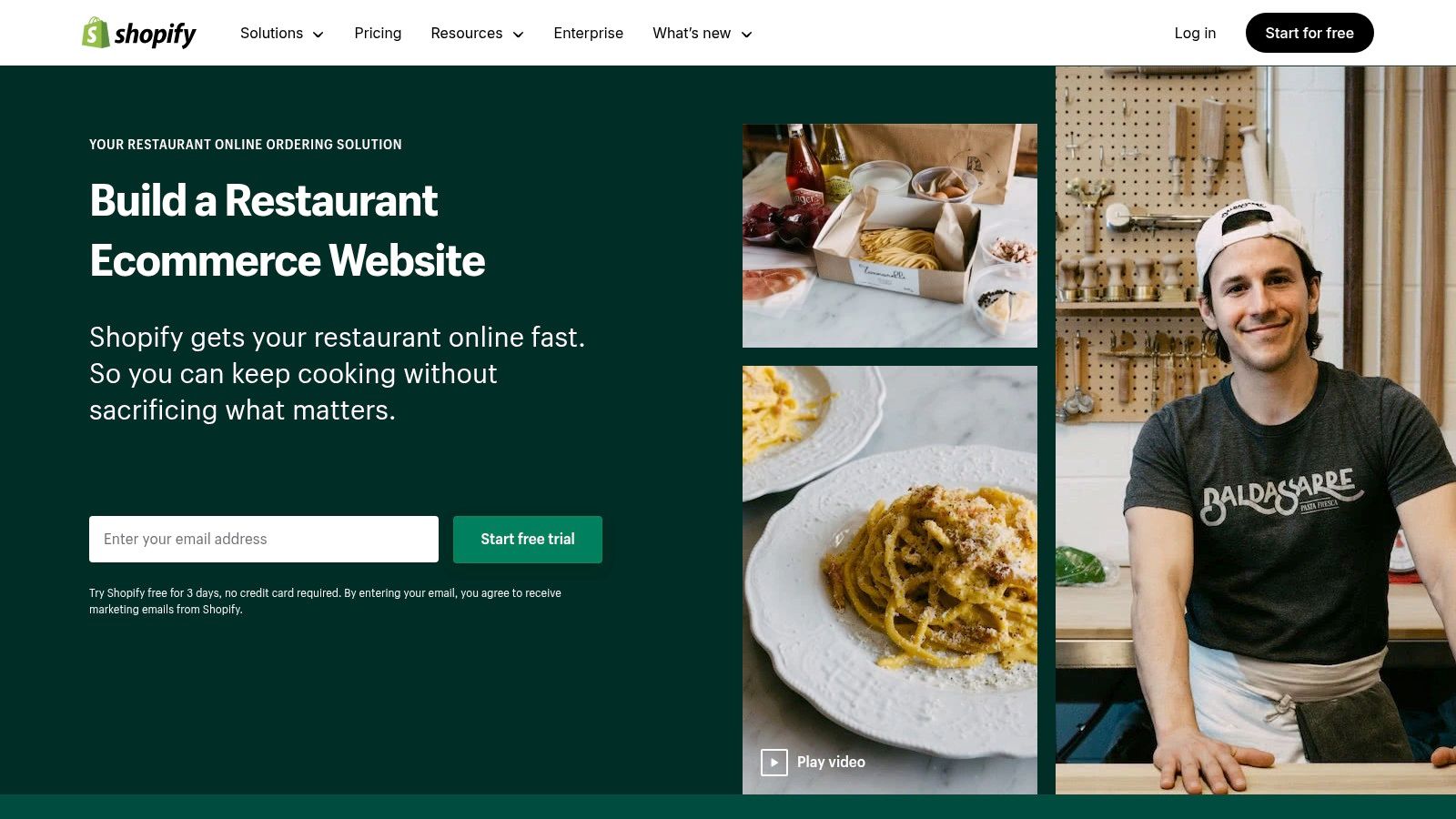
Shopify requires more initial assembly, using its extensive App Store to add specialized restaurant features like advanced menus and delivery zone management. This modular approach allows for a highly customized setup, bolstered by Shopify’s best-in-class payment processing and POS system. For those weighing its e-commerce-first approach, you can explore other platforms in our guide to top Shopify alternatives.
Key Features and Considerations
Shopify’s core advantage is its scalable infrastructure, but this comes at the cost of simplicity. You will need to install and configure several apps.
- Pricing: Plans start around $29/month, but costs increase with transaction fees and monthly fees for essential restaurant apps.
- Pros: Enterprise-grade reliability, excellent for scaling to multiple locations, and a rich app ecosystem.
- Cons: Requires more setup than dedicated restaurant tools, and total costs can rise with necessary app subscriptions.
- Best For: High-volume restaurants, multi-location chains, or ghost kitchens that need a robust, scalable e-commerce engine.
- Actionable Tip: Install a "Local Delivery" app from the Shopify App Store to define delivery zones by zip code and set custom delivery fees. This automates a complex part of the ordering process.
5. Square Online for Restaurants
Square Online extends its powerful point-of-sale ecosystem into the digital world, offering a streamlined path to online ordering for restaurants already using the Square POS. It excels at unifying in-person and online operations, creating a single source for menus, sales, and inventory. This makes it one of the best website builders for restaurants focused on operational efficiency and getting a transaction-ready site live with minimal cost.
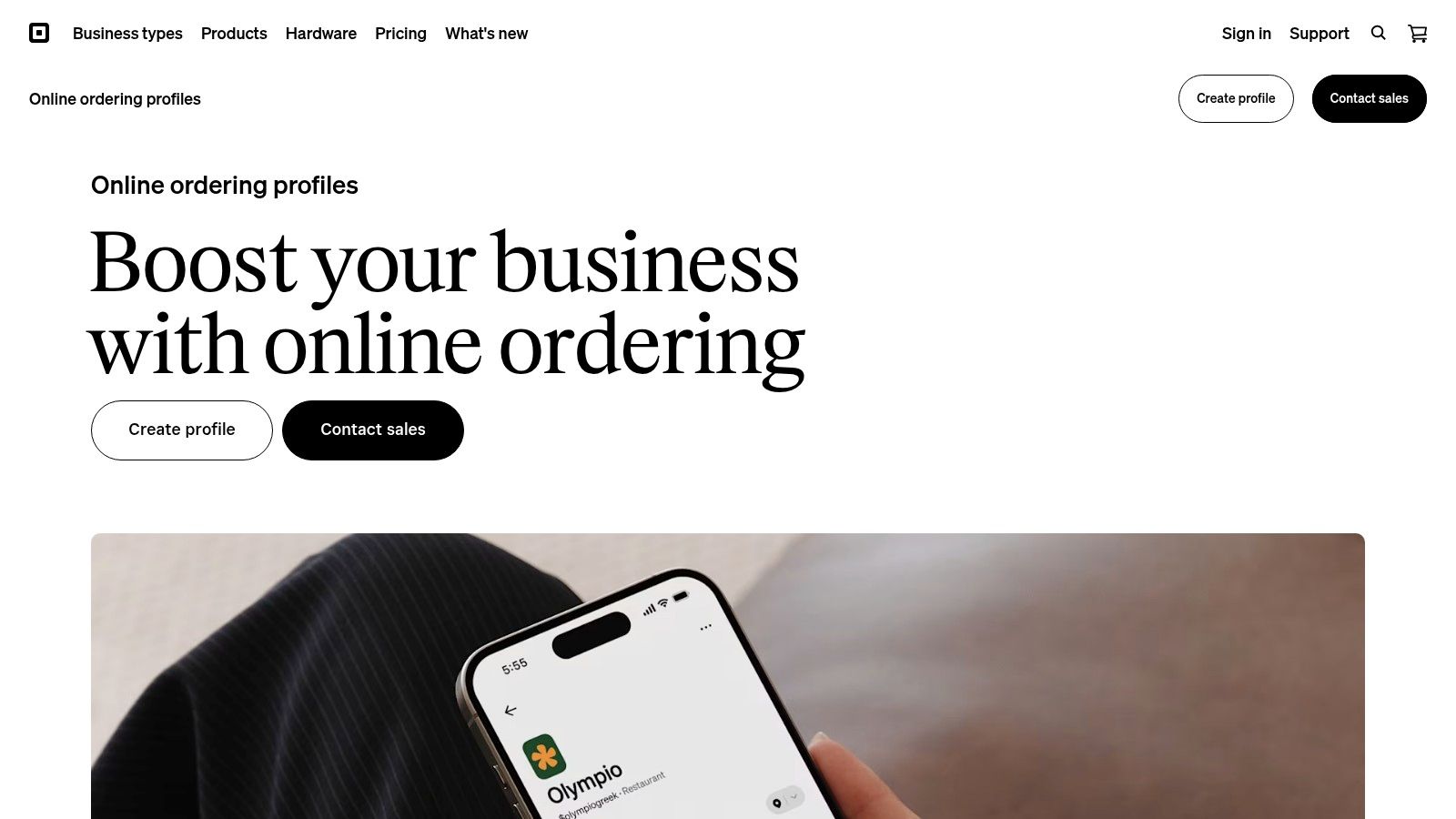
Instead of being a design-first platform, Square prioritizes function. It provides a free, professional online ordering page that syncs automatically with your Square for Restaurants POS and Kitchen Display System (KDS). This means online orders flow directly into your kitchen's workflow without manual entry, reducing errors and saving time. The integration with Square Payments also provides a seamless checkout experience.
Key Features and Considerations
Square’s main advantage is its deep integration, which simplifies tech management. However, this focus on function comes at the cost of creative control.
- Pricing: You can start with a completely free plan, paying only standard transaction fees. Paid plans (starting around $29/month) unlock features like custom domains.
- Pros: The free entry point is unbeatable, the POS and KDS integration is seamless, and it simplifies managing online and offline orders.
- Cons: Design and customization options are far more limited than tools like Wix or Squarespace.
- Best For: Existing Square POS users or new restaurants prioritizing a low-cost, tightly integrated system for online ordering.
- Actionable Tip: Enable the "Order Timing" feature to control order volume during peak hours. You can set limits on how many orders can be placed within a 15-minute window to prevent your kitchen from getting overwhelmed.
6. BentoBox
BentoBox is a hospitality-first digital platform that goes beyond being a simple website creator. It offers a comprehensive suite of tools purpose-built for restaurant operations, combining professionally designed websites with integrated marketing and management features. This platform is engineered to turn a restaurant's website into a revenue-generating asset, centralizing everything from online ordering to guest data.
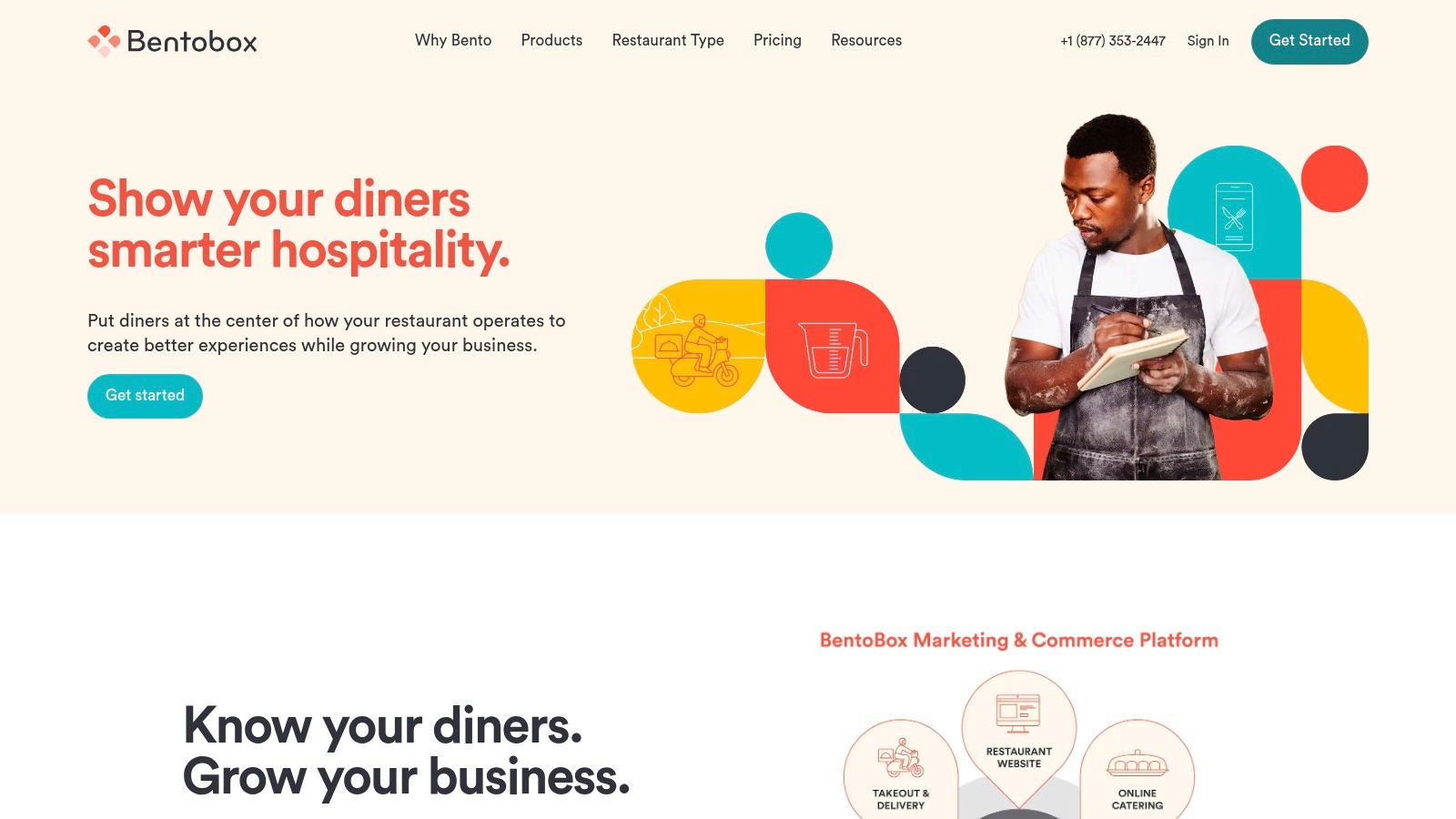
Unlike general-purpose tools, BentoBox’s entire ecosystem is designed for the food industry. It provides a managed experience where the initial website is built by their team. Its standout feature is BentoCore, a diner database that syncs with all its tools, including online ordering, reservations, and event management. This integration provides deep insights into guest behavior, making it one of the best website builders for restaurants focused on data-driven growth.
Key Features and Considerations
BentoBox's strength lies in its all-in-one, managed approach, which simplifies technology for busy restaurateurs.
- Pricing: Pricing is quote-based. You must contact their sales team for a custom quote.
- Pros: A comprehensive, hospitality-focused toolset, powerful menu and guest data management, and add-ons like ADA compliance tools.
- Cons: The lack of public pricing makes it difficult to budget, and its managed approach offers less DIY creative freedom.
- Best For: Established restaurants and hospitality groups that need a robust, all-in-one digital operations platform.
- Actionable Tip: Use the "Catering Store" feature to create separate, detailed menus for your catering services. This allows you to manage large orders and inquiries separately from your daily restaurant operations.
7. Popmenu
Popmenu is a comprehensive marketing and guest engagement platform designed for restaurants. It stands out by creating websites centered around dynamic, interactive menus that are engineered for search engine optimization. This approach helps restaurants attract new customers through search and then convert them with a rich, photo-driven menu experience, making it one of the best website builders for restaurants focused on growth.

Popmenu integrates its interactive menus with built-in online ordering, marketing automation, and direct syncing with your Google Business Profile. When you update your menu on the site, it can automatically update everywhere else. The platform also collects guest data, enabling powerful email and SMS marketing campaigns to drive repeat business, all managed from a single dashboard. For more information, you can visit the Popmenu website.
Key Features and Considerations
Popmenu’s core strength is its all-in-one, marketing-first approach, which automates many growth-related tasks.
- Pricing: Plans are subscription-based, starting around $149/month, reflecting its focus on being a full growth platform.
- Pros: Purpose-built for restaurants with a heavy emphasis on marketing, interactive menus that boost SEO, and excellent customer support.
- Cons: The entry price is higher than standard tools, and its full value is best realized when using the entire suite of tools.
- Best For: Restaurants that want a powerful, automated marketing engine and are willing to invest in a premium platform.
- Actionable Tip: Enable "Menu Remarketing" to automatically send an email to website visitors who viewed your menu but didn't place an order. This can recapture lost sales and bring customers back.
8. SpotHopper
SpotHopper is a specialized, "done-for-you" marketing and website platform built exclusively for the restaurant industry. It offers a service where their team builds, manages, and updates your site, ensuring it remains ADA-compliant and effective. This hands-off approach makes it a strong contender for restaurateurs who want a professional digital presence without dedicating time to technical maintenance.
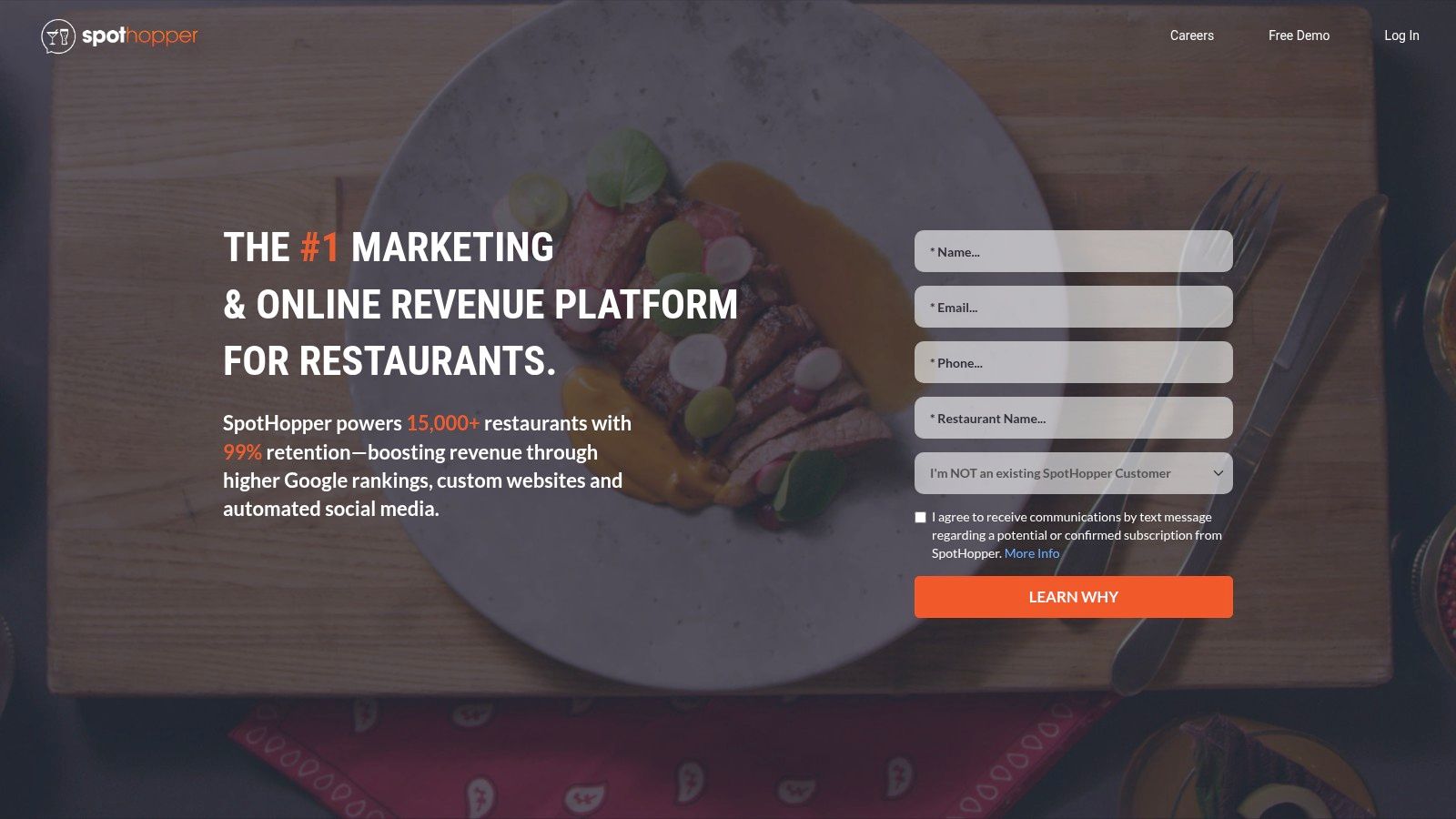
The platform distinguishes itself by deeply integrating marketing automation with website management. Beyond building the site, SpotHopper automates social media posts, email marketing campaigns, and even the creation of flyers based on your events and specials. This unified system helps you stay in front of customers with minimal effort, making it one of the best website builders for restaurants focused on marketing efficiency.
Key Features and Considerations
SpotHopper’s key advantage is its full-service model, which combines powerful technology with human expertise.
- Pricing: Custom pricing is provided after a personalized demo. You must contact SpotHopper for a quote.
- Pros: The "done-for-you" build and ongoing updates save time. Integrated marketing automation handles social media and email.
- Cons: The lack of public pricing requires a sales call. You have less direct DIY control over the website’s design.
- Best For: Busy restaurant owners who prioritize marketing automation and prefer to outsource their website creation and management.
- Actionable Tip: When you add a new special or event to your website, schedule it to auto-post to your Facebook and Instagram through the SpotHopper dashboard to maximize visibility with zero extra work.
9. GloriaFood (by Oracle)
GloriaFood, now part of Oracle, centers its platform on a powerful, freemium online ordering system. It’s designed for restaurants whose primary goal is to enable commission-free online ordering quickly and affordably. Instead of building a complex site, GloriaFood provides a sales-optimized, single-page website or a widget that can be easily integrated into an existing site, making it a pragmatic choice for establishments focused on functionality over design.
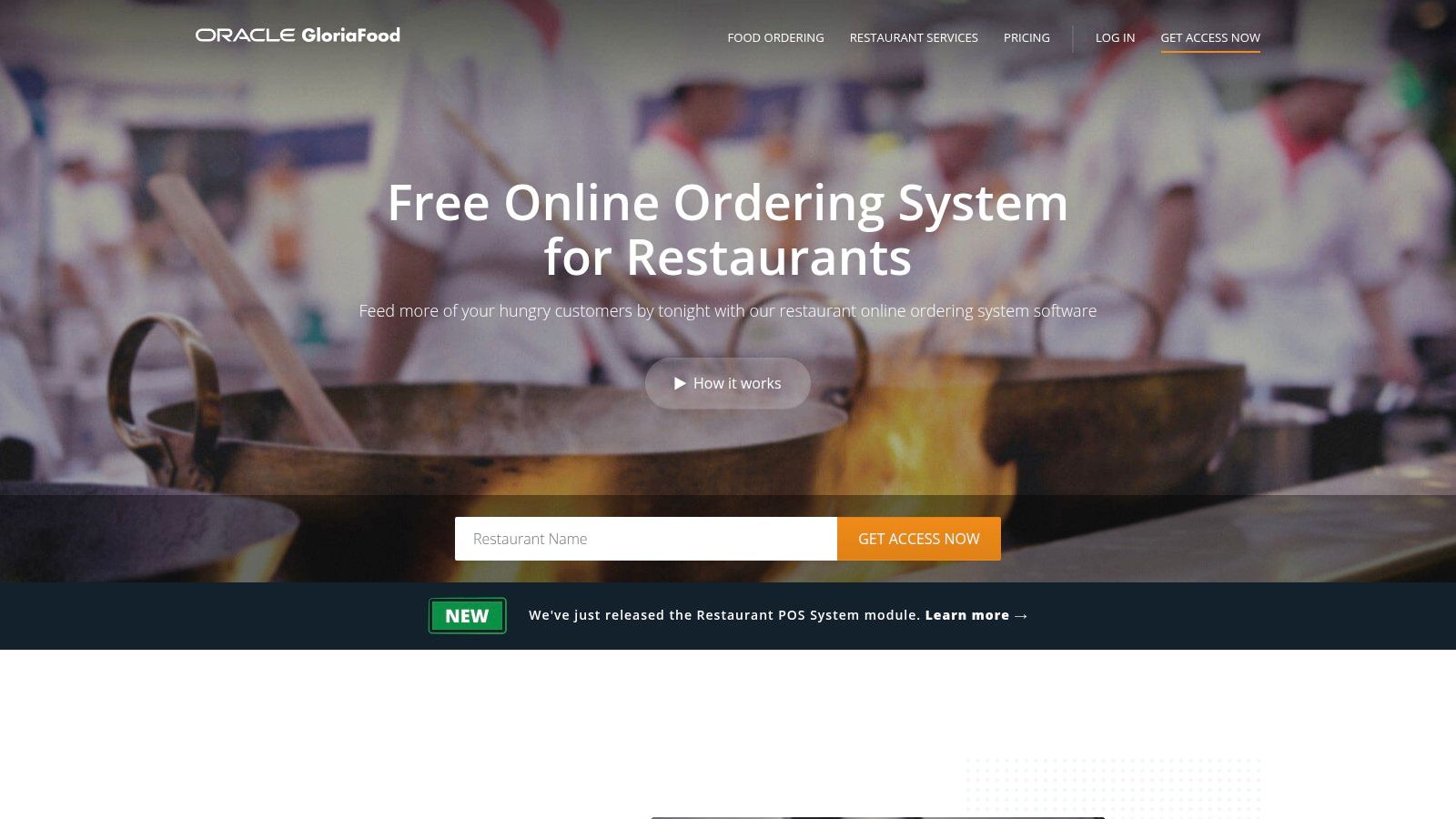
This platform excels at facilitating unlimited, commission-free orders. The setup is straightforward, allowing you to generate a functional ordering menu and publish it online in minutes. While the free plan is robust for basic order-taking, GloriaFood operates on a premium add-on model for features like online credit card payments, promotions, and table reservations. This makes it one of the best website builders for restaurants on a tight budget needing a reliable online ordering engine.
Key Features and Considerations
GloriaFood’s strength lies in its "ordering-first" philosophy, which simplifies the process for both the restaurant and the customer.
- Pricing: The core online ordering system is free. Paid add-ons are available, such as online payment processing (starting at $29/month).
- Pros: Completely free to start with zero commissions, exceptionally easy to set up, and can be added to any existing website.
- Cons: The website creator functionality is very basic and template-driven. Essential features like online payments require paid subscriptions.
- Best For: Restaurants that already have a website and need a powerful, commission-free ordering system, or new establishments wanting the most cost-effective way to start taking online orders.
- Actionable Tip: Download the GloriaFood order-taking app on a dedicated tablet for your front-of-house staff. This creates a reliable, audible alert system for new online orders, ensuring none are missed during busy shifts.
10. WordPress.com (Restaurant Sites)
WordPress.com offers a powerful and scalable foundation for restaurant owners who prioritize content ownership and long-term flexibility. Unlike template-driven tools, it provides a full-fledged Content Management System (CMS) that can grow from a simple site into a complex digital hub with advanced blogging and e-commerce. This makes it one of the best website builders for restaurants that anticipate future growth and want total control over their digital destiny.
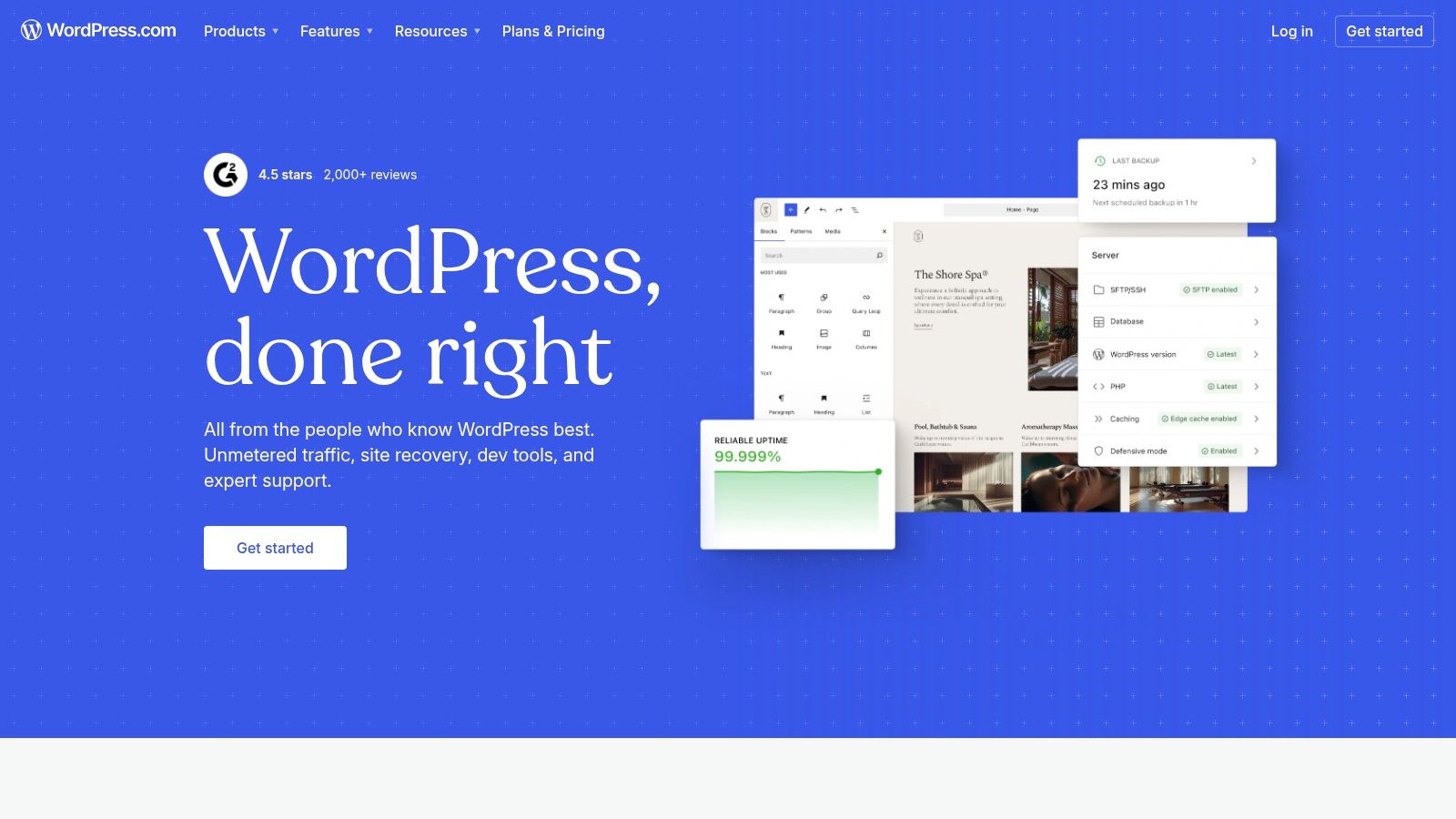
The platform uses restaurant-specific themes and modern block-based editing that allows for easy integration of menu blocks and reservation forms. By connecting plugins like WooCommerce for online ordering or using the OpenTable integration block, you can build a custom solution. While it demands more technical setup, its SEO tools and content flexibility are unmatched.
Key Features and Considerations
WordPress.com's strength lies in its limitless customization through a vast ecosystem of plugins and themes, but this power comes with a steeper learning curve.
- Pricing: A Business plan (around $25/month billed annually) is required to install plugins for online ordering and reservations.
- Pros: Highly customizable and flexible CMS, a massive ecosystem of themes and plugins, and scalable from simple to complex websites.
- Cons: Requires more setup and maintenance. Key features often depend on higher-tier plans or paid plugins.
- Best For: Restaurants with a long-term content strategy, such as a blog or events calendar, that need a scalable platform they won't outgrow.
- Actionable Tip: Install the "Restaurant Menu" plugin by MotoPress. It provides a user-friendly interface for creating and managing categorized menus with images, prices, and detailed descriptions, separate from your standard pages.
11. GoDaddy Website Builder (with Restaurant Templates)
GoDaddy Website Builder is designed for speed and simplicity, making it an excellent entry point for restaurant owners who need a basic online presence without any technical fuss. Its AI-assisted site creation tool asks a few questions about your restaurant and generates a foundational website in minutes. This makes it one of the best website builders for restaurants prioritizing a fast, no-frills launch over deep customization.
GoDaddy bundles essential marketing tools directly into its plans, including email marketing, social media integration, and an SEO wizard. While it lacks native, commission-free ordering systems like specialized competitors, its e-commerce functionality can be adapted for simple menu item sales. The all-in-one approach simplifies billing and support. If you're exploring straightforward platforms, see how GoDaddy measures up in our guide to the best website builders for small businesses.
Key Features and Considerations
GoDaddy’s strength is its guided, section-based editor, which makes it nearly impossible to create a poorly designed site, though this comes at the cost of creative freedom.
- Pricing: E-commerce plans, required for online sales, start at around $20.99/month.
- Pros: Extremely easy and fast AI-powered setup, 24/7 customer support, and built-in marketing features.
- Cons: Limited design flexibility, no dedicated app store, and lacks a robust, built-in online ordering system.
- Best For: Small restaurants, cafes, or food trucks needing a simple, professional, and affordable website with minimal time investment.
- Actionable Tip: Use the built-in "Appointments" feature to manage table reservations. You can set your available hours, block off holidays, and even accept online payments for special event bookings.
12. UpMenu (Restaurant Website Builder + Online Ordering)
UpMenu is a highly specialized platform designed to serve as a comprehensive digital operations hub for restaurants. It combines a user-friendly website creator with a powerful, built-in online ordering system, robust marketing automation, and even optional branded mobile apps. This focus on creating a direct-to-customer ecosystem makes it one of the best website builders for restaurants aiming to reduce reliance on third-party delivery apps.
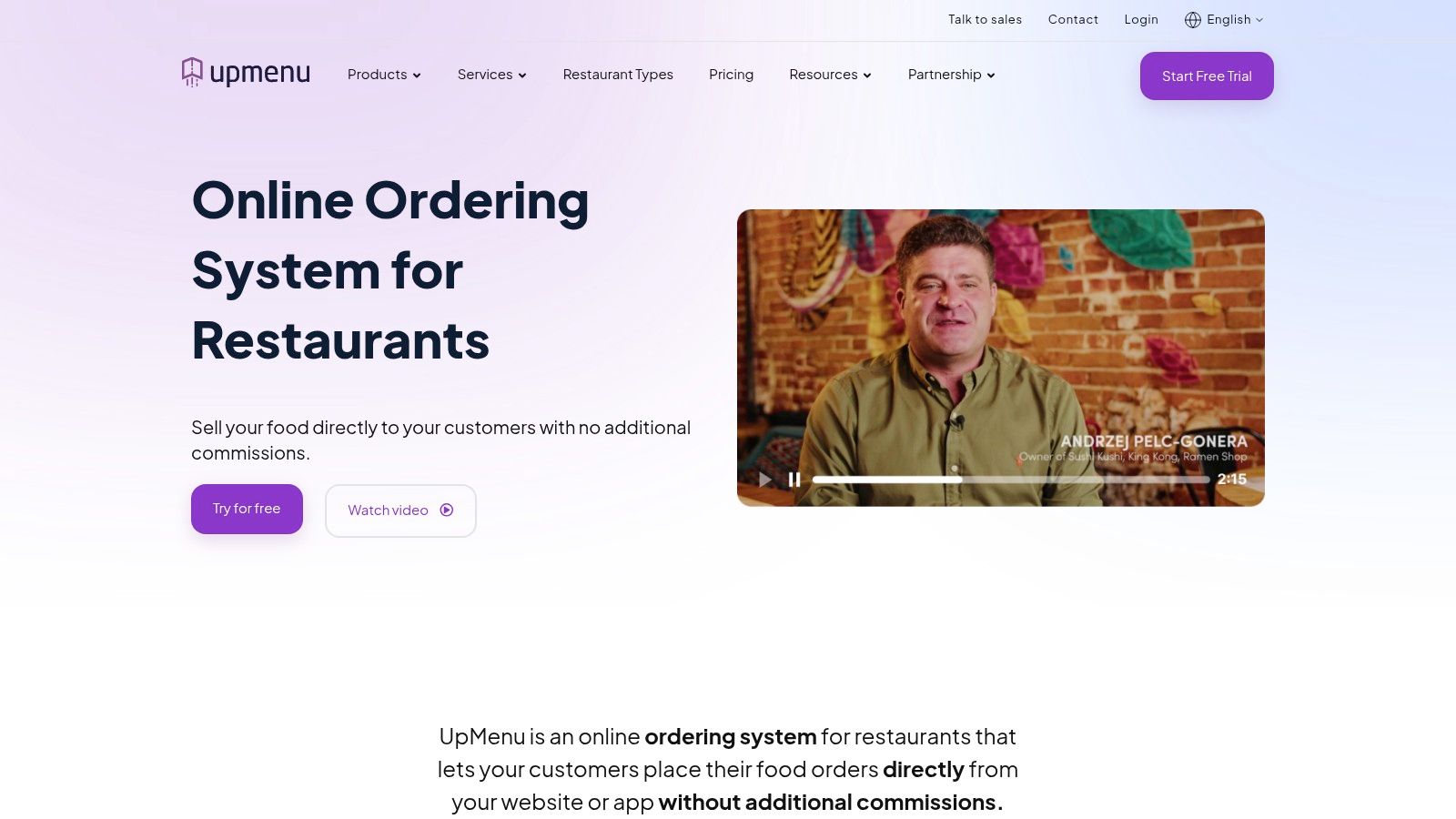
Unlike general-purpose tools, UpMenu’s strength lies in its integrated marketing tools. Features like loyalty programs, automated SMS and email campaigns, and push notifications are included in its core offering. This allows restaurant owners to manage their website, ordering, and marketing from a single dashboard. The platform is built to help you grow your own customer base directly. You can find more details on their system at upmenu.com.
Key Features and Considerations
UpMenu’s drag-and-drop editor and 40+ templates make website creation straightforward, while its backend is packed with restaurant-specific operational tools.
- Pricing: A limited free plan is available. Paid plans start around $49/month.
- Pros: Exclusively focused on restaurant needs, powerful marketing and loyalty tools included in paid plans, and clear pricing for scaling.
- Cons: The free tier has significant limitations, and lower-tier plans have order caps.
- Best For: Restaurants that want to own their customer relationships and drive repeat business through an integrated ordering and marketing system.
- Actionable Tip: Launch a simple loyalty program using UpMenu's built-in tools. For example, offer a 10% discount after a customer's fifth order. The system tracks this automatically, encouraging repeat business without extra manual work.
Top 12 Restaurant Website Builders Comparison
| Product | Core Features | User Experience / Quality | Value Proposition | Target Audience | Price Point |
|---|---|---|---|---|---|
| Solo AI Website Creator | AI-driven no-code site creation, custom domain, booking, SEO, analytics, collaboration | Intuitive, fast setup, mobile-optimized | Completely free, no hidden fees or ads | Entrepreneurs, freelancers, small businesses, multi-industry | Free |
| Wix Restaurants | Restaurant templates, menus, reservations, payments, marketing tools | Polished designs, fast launch | All-in-one, strong native features | Restaurants | Paid, with add-on apps |
| Squarespace (Restaurant) | Design-led restaurant templates, integrations with Tock and ChowNow | Excellent design, simple editor | Aesthetic focus with built-in marketing | Design-conscious restaurants | Paid, no free tier |
| Shopify for Restaurants | Ecommerce-grade, menu, tipping, delivery, POS, extensive apps | Reliable, scalable, enterprise-grade | Robust platform with rich integrations | Medium-large restaurants | Paid, app fees apply |
| Square Online for Restaurants | Free ordering page, integrated payments, delivery/pickup, POS sync | Easy setup, unified online & offline ops | No monthly fee to start, transaction fees only | Small-medium restaurants | Free start, transaction fees |
| BentoBox | ADA tools, ordering, catering, gift cards, marketing, reservations | Comprehensive hospitality features | Full hospitality toolset | Hospitality businesses | Quote-based pricing |
| Popmenu | SEO-driven interactive menus, ordering, marketing automation | Strong marketing focus, good onboarding | Restaurant growth platform | Marketing-driven restaurants | Higher entry price |
| SpotHopper | ADA compliance, reservations, table management, marketing automation | Done-for-you builds, ongoing updates | Full front-of-house plus marketing | Restaurants needing managed sites | Quote-based pricing |
| GloriaFood (by Oracle) | Commission-free orders, ordering widgets, optional app/add-ons | Simple ordering setup | Free core ordering, affordable add-ons | Cost-conscious restaurants | Freemium |
| WordPress.com (Restaurant) | Themes, WooCommerce, OpenTable, SEO, plugins | Highly customizable, scalable | Flexible CMS | Tech-savvy restaurants | Free tier, paid plans/plugins |
| GoDaddy Website Builder | AI-assisted creation, restaurant templates, marketing, ecommerce | Beginner-friendly, fast setup | Low-cost, simple sites | Beginners, small restaurants | Paid |
| UpMenu | Restaurant templates, ordering, loyalty, marketing, multi-location | Focused on restaurant ops, marketing tools | Direct ordering, loyalty, multi-location | Restaurants with online ordering | Free limited, paid tiers |
Making Your Final Selection: The Right Platform for Your Table
Choosing from the best website builders for restaurants comes down to aligning a tool’s strengths with your specific needs, budget, and growth plans. The right platform is a digital extension of your hospitality, a central hub for operations, and an engine for attracting new diners.
Platforms like BentoBox, Popmenu, and SpotHopper offer deep, restaurant-specific functionality but often come with a higher price tag. On the other end, tools like Squarespace and Wix provide stunning design flexibility but may require third-party apps for specialized functions like table management, potentially adding to your monthly costs.
Your Action Plan for Choosing
To make a confident choice, focus on the one that does what you need, exceptionally well.
Here’s a practical framework to guide your decision:
- Define Your Core Need: Is your primary goal online ordering, or is it attracting new customers with a visually stunning site? For speed and simplicity, an AI-powered tool like Solo AI Website Creator is a strong contender. For a comprehensive marketing suite, consider Popmenu.
- Audit Your Existing Systems: List the tools you already use, like your POS system or reservation platform. Choosing a tool that integrates seamlessly, like Square Online for Square POS users, will save you significant operational headaches.
- Calculate the True Cost: Look beyond the monthly fee. Factor in payment processing percentages, costs for premium add-ons, and any setup fees.
- Test Drive Before Committing: Almost every platform offers a free trial or a free plan. Use it. Build a test site, upload your menu, and test the ordering process. This hands-on experience is the most effective way to determine if a platform feels right for you.
Ultimately, the best website builder for your restaurant empowers you to manage your digital presence efficiently, freeing you to focus on your food and guests. Choose the tool that feels like a partner, not a chore.
Ready to get your restaurant online in minutes without the technical hassle? Solo AI Website Creator uses AI to generate a professional, SEO-friendly website complete with text, images, and a layout tailored to your restaurant, all for free. See how easy it is to build your digital storefront and start attracting more customers today at Solo AI Website Creator.
